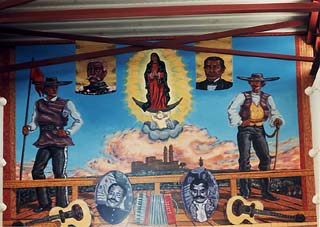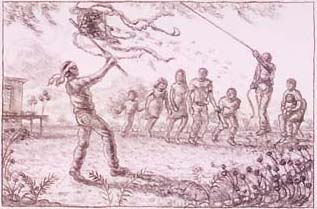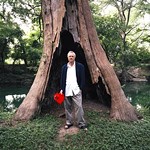A Painter's Work
By Sam Martin, Fri., Jan. 22, 1999
|
|
Fidencio Duran is a regular guy. He lives in a nondescript, one-story house with Debbie, his wife of four years, and Zack, their impossibly large Doberman pinscher. The 38-year-old painter is mild-mannered and shy, and unlike one of his artistic influences, Salvador Dali, he doesn't wear elaborate moustachios or the latest fashion. Even inside his studio, you won't find the unruly pastiche of used paint tubes and discarded paraphernalia that other artists of his caliber might absent-mindedly collect. No, for Fidencio Duran there is only one thing that makes him unusual: his painting. Plain and simple, it's damn good.
I know this partly because I've seen his murals. The unrivaled artistic merit that went onto the walls inside Parque Zaragosa Recreation Center alone should be singled out on the city's tourist map. But I also know it because he is the only artist in the history of the Dallas Museum of Art to win all three of its artistic merit awards: the DeGolyer Memorial Award in 1983, the Arch and Anne Giles Kimbrough Award in 1990, and the Dozier Travel Grant in 1996. According to Ricardo Hernandez, assistant director at the Texas Commission on the Arts (TCA), Duran has also been the most sought-after resident artist in the state for the last 11 years.
So it was no surprise when he pulled down the attic stairs in his living room and led me up to the cramped studio he uses "to do a watercolor or a drawing" that I discovered frame after frame of stellar works of art marked with Duran's distinctive elongated figures and Rennaissance-like depth of field. Even then, the works that really caught my eye were the charcoal studies of "The Visit," the work-in-progress that will be installed above the main ticket counter at Austin-Bergstrom International Airport in April and which is also the subject of the current exhibition at Lyons Matrix Gallery. Needless to say, this work is far from regular.
Duran grew up just east of Lockhart in Maxwell, Texas, a tiny farming town "with five bars and a wooden coat hanger factory." He is the third youngest in a family of six boys and two girls, and his parents were tenant farmers, living and working the land for a share of the profits. His dad moved to Texas from Central Mexico in the 1930s and relentlessly told his children stories about their Mexican heritage. Duran points to his family when he talks about the subject matter of his artwork.
"My father wanted all of us to know where we came from," Duran explains. "So he constantly told us stories about his hometown and his family. In fact, in seventh grade I wrote a paper in a writing competition about my dad's experience growing up in Mexico and I won first place. That's when the seeds were planted to make my work more personal to my own experience." Lucky for us he decided to pursue painting instead of prose.
|
|
The way Duran explains it to me, painting and art seem to have been what he was going to do from very early on. He started doodling and drawing when he was about 13, taking the example of his older brothers who were dabbling in the arts for a little while. When they stopped, he kept going. During his childhood, his parents didn't think too much about him scribbling all over everything; he was a good student and never caused too much trouble. "They neither encouraged nor discouraged me," he remembers. Even from the small amount of time I've spent with the artist, I can picture a quiet kid silently copying down the images in his childhood -- images that would eventually become the masterpieces of his adult life.
By the time he reached Lockhart High, Duran was enrolling himself in art classes, and in 1978, during his junior year, he took part in the Arts and Education Program being offered in his school by the Texas Commission on the Arts. The artist in residence in Duran's school district that year was a young ceramist named Ricardo Hernandez.
"When I got to Fidencio's school," Hernandez recalls, "one of his art teachers pulled me aside and told me she had this one student she wanted me to focus on. She showed me a very typical teenager painting he had done of a guy in a full lotus position playing a guitar with a Fender amp behind him. She was very excited about him and thought that, since I was there as a resource, the best thing that I could possibly do was to focus on this guy. I guess ultimately when we look back on it, she was quite wise in her assessment."
In the end, Hernandez never actually taught Duran anything as much as he just gave the 17-year-old the materials he needed and the space in which to work. With the keys to the studio, Duran kept plugging away at his art by himself, taking occasional guidance from Hernandez. "He was always there," Hernandez says. "From a very early age, he developed some really good studio habits, and if you're going to point to something that ultimately led to his success, it's that. He's now incredibly prolific."
After graduation, Duran attended the University of Texas at El Paso for two semesters before transferring to UT-Austin, where he was introduced to the work of Spanish surrealist painter Salvador Dali. More than any other influence, Dali's is most apparent in Duran's work. Both artists' paintings feature realistic depictions of the human figure set in fantastic environments. At the same time, when Duran is asked which artist inspired him the most, he replies, "All artists who I like inspire me with their lives."
In 1983, Duran received his Bachelor of Fine Arts and was soon thereafter awarded the first of the DMA awards granted to promising young artists. During this period, the artist also landed a show at the Dougherty Arts Center with the Austin Visual Arts Association's Spring Show. Peter Saul was among the other artists showing in the exhibition, and Duran garnered some early media attention in the local Third Coast Magazine. The relationship Duran formed with the AVAA ended up lasting over the years, leading to last weekend's grand opening of the association's newest space on Alexander Avenue for which Duran donated four charcoal sketches worth about $2,500. The sketches were raffled off to some lucky soul with the right five-dollar ticket.
Seventeen years after his first professional accolades, Duran has managed to work non-stop as a muralist, a gallery artist, and as a resident artist for TCA's Arts and Education Program (the only exception was in 1987 and '88 when the economy went sour, during which time he worked at Chuy's restaurant on Barton Springs to pay the bills). With TCA murals all over the state in places such as Crystal City, Edinburg, Levelland, Palacios, and Tyler, Duran is quietly leaving a small but rapidly growing legacy wherever he goes. "There are probably lots of others who would reject the notion of a leader," Hernandez says of his longtime friend and student. "But I tend to be one of those people who believe in the notion of leading by example. Fidencio is a great example for any artist because he truly has become a master."
I'm standing in the middle of an industrial warehouse somewhere off Braker Lane and I-35 that is the artist's main studio. Surrounding me are nine enormous canvas panels that, when finished, will represent Austin and the surrounding region for hundreds of thousands of travelers for years to come. The series is appropriately entitled "The Visit."
"I don't use models," he tells me when I ask him who the figures are in the paintings. "I get the feeling that the painting then becomes about the model and that takes away from the whole piece. I want my work to reflect my personal experience so I paint everything from memory." He says these things with a calm nonchalance that is neither prideful nor boastful, as though that's the way everyone paints.
|
|
The nine panels will be installed in groups of three (two square 9'x9' canvases on either side of a 9'x12' canvas) and will be placed side by side along one huge wall in the main lobby of the new airport. The setting of the series is a rural cottage where a family reunion is taking place. Children are playing dominoes and volleyball. Someone waters the garden. An old man tells stories with a friend who plays the accordion.
The work-in-progress looks very Dali-esque in its unfinished state. Where Duran has sketched in the slender, elongated figures over the background landscape, some look as though they are disappearing on the horizon, like distant memories. He tells me that another friend likes them this way, too. He says they remind him of the way people and memories fade into and out of life.
But the way Duran paints is the reason for this ephemeral imagery. "I start with the background and work toward the viewer," he says, gesturing with his hands as if he's reaching into the painting to pull the finished work toward the two of us with clenched fists. He tells me that he starts and finishes the same section in each panel before going on to something else. For example, one day he'll come in and paint nothing but sky and clouds. The next day, he'll come in and paint the tiny trees that make up the background. Then the house and the larger trees in front and last of all the figures.
Like every step that Duran has made along his quiet, steady rise to the top, this masterpiece is thorough and determined. He has taken his time, paid excruciating attention to detail, and in the end painted exactly what he wanted to paint. In a way, this is surely the greatest success any artist can hope to accomplish.
"There were some times I did wonder how I could get my art to a level at which it could sustain me," Duran says. "But I never thought I wouldn't be able to survive with my art. There are always different ways to make money in this business, whether it be workshops or teaching or selling the work. I've found that as long as you can find it within yourself to produce something that's meaningful to you, it's more than likely going to be meaningful to someone else." Honest words and simple hard work: What an unusual man.
"The Visit" is on display through February 25 at Lyons Matrix Gallery, 1712 Lavaca. Call 479-0068 for information.





 Taking Flight by Fidencio Duran
Taking Flight by Fidencio Duran  Detail from the mural at Parque Zaragosa Recreation Center, by Fidencio Duran
Detail from the mural at Parque Zaragosa Recreation Center, by Fidencio Duran  Charcoal sketch from the "New Home" series, by Fidencio Duran
Charcoal sketch from the "New Home" series, by Fidencio Duran 


